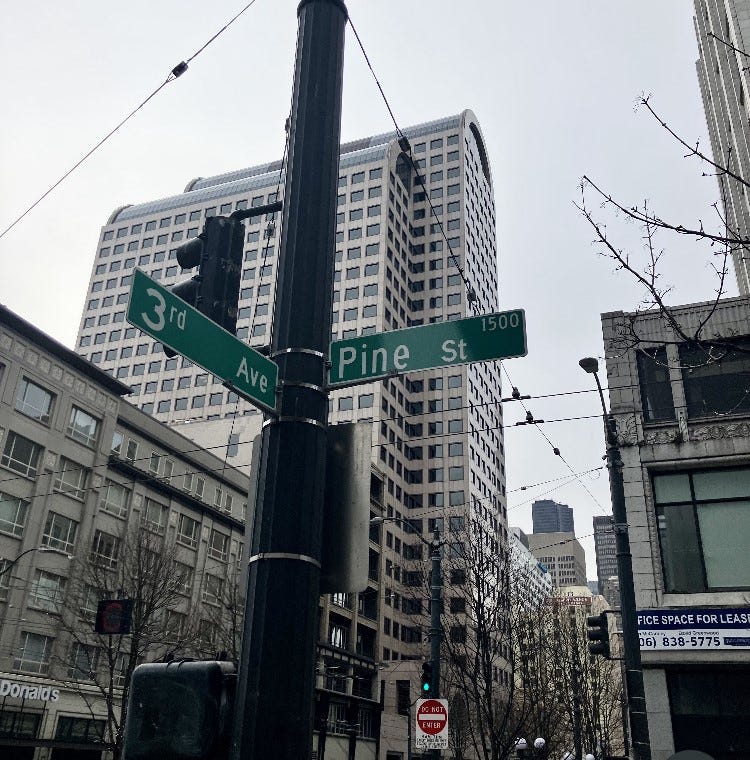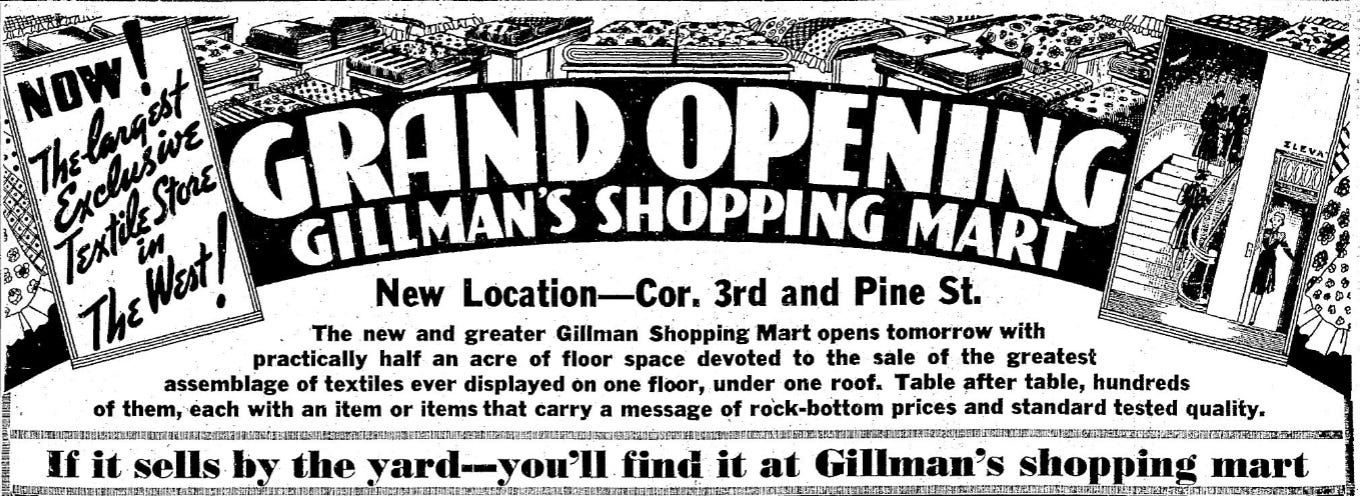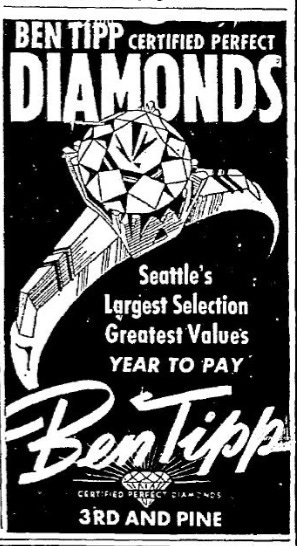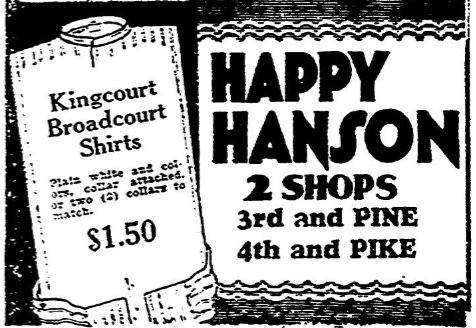Throughout Seattle’s history, several different locations have served as “the bad parts of town” – those violence-prone areas full of sketchy characters and illicit economies, where people go to seek out drugs, prostitutes and various black-market offerings. In the early 1900s, it was the Tenderloin district that held this distinction. Now known as Pioneer Square, the notorious neighborhood once boasted a brothel, saloon and gambling parlor on nearly every corner. Several decades later, when Pioneer Square started revitalizing itself as an historic district, all this vice was squeezed northwards along 1st Avenue, which during the 1960s and ‘70s, became known as “Flesh Avenue” due to the bawdy array of peep shows, adult bookstores, pawn shops, taverns, tattoo parlors and strip clubs. Also known as “Hustler’s Row,” 1st Avenue was perhaps best immortalized in the gritty documentary, “Streetwise.”
Things started changing in the 1980s following the renovation of the Pike Place Market. This prompted a clean-up of the area with the development of several nearby hotels, condominiums and office buildings. All this gentrification, in turn, pushed the more unlawful elements up a couple blocks to an area that has since become known as “The Blade.” Located in the downtown Pike/Pine corridor, the corner of 3rd Avenue and Pine Street (marked by the golden arches of the infamous McDonald’s that is located there) has since become established as The Blade’s epicenter. For the Seattle Police Department, this troublesome and well-known intersection is simply known as “3P.”
Despite 3rd and Pine’s current reputation, it has a surprisingly glitzy and glamorous past. Going back to the 1920s, it was a popular streetcar stop for those wanting to enjoy the more luxurious side of life as the intersection featured an impressive array of upscale shopping. The Bon Marche opened their flagship department store there in 1929, and the corner was also the location of a popular piano store, a fine jeweler, as well as the ritzy Melrose Hotel.
The area retained this opulent charm for the next several decades. Even the opening of the McDonald’s there in 1979 was a fancy affair. It was the first McDonald’s to open in downtown Seattle, which at the time was considered a big deal. Many local businesses were thrilled about the retail jolt that it was expected to bring, and an elegant party was held for its grand opening in which local restaurateur, Victor Rosellini, served hors d-oeuvers and champagne to the musical accompaniment of a jazz trio.
During the early 1980s, one of the city’s first stores to sell personal home computers – appropriately named ComputerLand – operated there until 1986. With the arrival of crack cocaine in the mid-’80s, however, a noticeable downward shift began to take place. The McDonald’s, which had once been the toast of downtown, was becoming known as being a hang-out for the area’s drug dealers. There was more trash on the streets, more visible graffiti, and the only new retail store to open was a discount shoe store.
During the next few years, the corner gained increasing notoriety due to the gangs, drugs, guns and violence that had slowly moved in, and it became the place that out-of-towners were strongly warned to avoid. The McDonald’s, which now serves as a symbol of the infamous corner, made the local news when a Seattle Police officer shot a man inside there in 1995; and during the WTO riots of 1999, anti-beef protestors shattered windows and spray-painted graffiti on its walls. By the early 2000s, the corner had become a regular feature on the nightly news.
In 2007, a series of violent incidents further cemented 3rd and Pine’s growing infamy. A 16-year-old girl was stabbed on the corner. This was soon followed by a shooting that left one person dead, which was then followed by a violent beating that was caught on video and widely shown on the local news. In response, the mayor vowed immediate action and the Seattle Police Department stepped up their presence. Everyone seemed to breathe a sigh of relief that the area had finally been cleaned up. Within a year, though, police presence there had returned back to normal levels and all the bad elements slowly made their return. In 2011, on a Sunday afternoon, a man was stabbed in front of his family after they stepped off a Metro bus at the corner.
Despite numerous police attempts to control the intersection, as well as all the continuing media attention, crime there only seemed to increase. A large-scale drug bust was carried out in The Blade in 2015 in which Seattle police and federal agents conducted a joint sting operation, resulting in 95 arrests. It barely made a dent, though, as the rate of narcotic-related crimes continued to soar. At the time, heroin was still the top street drug, though a new opioid synthetic known as fentanyl was beginning to grow in popularity.
Macy’s (formerly the Bon Marche) closed their historic store there in 2019. Thanks to online retail, department stores have been on a slow death spiral and so the closure was primarily due to economic reasons rather than the surrounding crime. However, the departure further punctuated just how badly the area had deteriorated.
On the evening of January 22, 2020, as nearby office workers gathered at downtown bus stops for their commutes home, gunfire suddenly broke out in front of the McDonald’s, resulting in instant pandemonium. People getting off their buses were met by people running from the shooting and after the smoke cleared one woman lay dead with seven others injured, including a 9-year-old boy. Naturally, the violence garnered a high degree of media coverage, with the governor even issuing a statement about the incident, and there were now very public calls to permanently close the McDonald’s and tear it down completely.
A couple months after the shooting local crime statistics would quickly become overshadowed by the outbreak of COVID-19. The pandemic triggered a global shutdown, including in Seattle where only businesses deemed “essential” were initially allowed to stay open. The economic disruption resulted in increased rates of homelessness, which coincided with fentanyl surpassing all other narcotics as the drug of choice amongst street addicts. While the city’s attention was focused on navigating the complexities of a global pandemic, several downtown streets became overrun by homeless encampments, and 3rd and Pine developed into an open-air drug market.
Out on the streets, fentanyl is sold in a pill form that is popularly known to addicts as “blues.” These fentanyl pills are heated on pieces of tin foil and the fumes are then inhaled through a straw. Black tar heroin used to be the number one street drug in downtown Seattle, but fentanyl has a lower street price as it’s much easier to manufacture and smuggle, thus making it the current drug of choice for local junkies. By the end of 2020, the discarded orange-capped heroin needles that had previously littered the streets quickly became replaced with burnt pieces of tin foil: a visual reminder of the changing times.
As of the date of this writing, 3rd and Pine still holds the crown as “the bad part of town.” However, as post-COVID life has slowly returned back to some semblance of normalcy, the local media’s attention has shifted back to homelessness, crime and the fentanyl epidemic. Likewise, the Seattle political machine is poised for some major changes, with many City Council candidates platforming around these issues. Whatever the outcome is, the future of “3P” remains unclear.






Interesting read, Brad. A couple of comments:
You write that the Macy's closure was "due to economic reasons rather than the surrounding crime." While the national decline of in person department store shopping was certainly a major driving force behind the closure, my understanding is that rampant shoplifting at the Macy's was also a significant contributor to the company's decision to shutter the location.
Second, in your close you rightly point out that media (and public) attention has recently turned to "homelessness, crime and the fentanyl epidemic." But, conta to how you close your piece, I'm actually surprised at how little the current crop of City Council candidates (with a handful of exceptions) are platforming on those issues. I suspect many of them are hand waving past these issues because, at least to some extent, Thunderdome-ish problems with entrenched encampments, (the not unrelated question of) worsening crime (or at least the perceptions of worsening crime and street disorder downtown), and the fentayl-and-meth driven overdose crisis on our streets makes for an awkward fit with some of Seattle's current movement progressive orthodoxies.